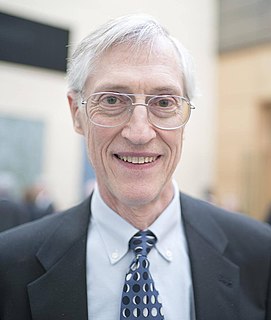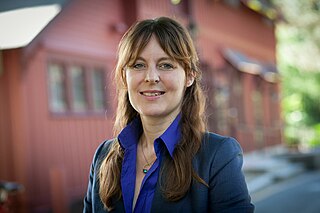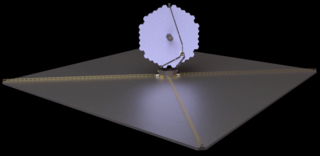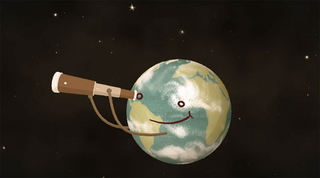
The Spitzer Space Telescope, formerly the Space Infrared Telescope Facility (SIRTF), was an infrared space telescope launched in 2003. Operations ended on 30 January 2020. Spitzer was the third space telescope dedicated to infrared astronomy, following IRAS (1983) and ISO (1995–1998). It was the first spacecraft to use an Earth-trailing orbit, later used by the Kepler planet-finder.

The Goddard Space Flight Center (GSFC) is a major NASA space research laboratory located approximately 6.5 miles (10.5 km) northeast of Washington, D.C. in Greenbelt, Maryland, United States. Established on May 1, 1959 as NASA's first space flight center, GSFC employs approximately 10,000 civil servants and contractors. It is one of ten major NASA field centers, named in recognition of American rocket propulsion pioneer Robert H. Goddard. GSFC is partially within the former Goddard census-designated place; it has a Greenbelt mailing address.

A coronagraph is a telescopic attachment designed to block out the direct light from a star so that nearby objects – which otherwise would be hidden in the star's bright glare – can be resolved. Most coronagraphs are intended to view the corona of the Sun, but a new class of conceptually similar instruments are being used to find extrasolar planets and circumstellar disks around nearby stars as well as host galaxies in quasars and other similar objects with active galactic nuclei (AGN).

A carbon planet is a theoretical type of planet that contains more carbon than oxygen. Carbon is the fourth most abundant element in the universe by mass after hydrogen, helium, and oxygen.

The New Worlds Mission is a proposed project comprising a large occulter flying in formation with a space telescope designed to block the light of nearby stars in order to observe their orbiting exoplanets. The observations could be taken with an existing space telescope or a dedicated visible light optical telescope optimally designed for the task of finding exoplanets. A preliminary research project was funded from 2005 through 2008 by NASA Institute for Advanced Concepts (NIAC) and headed by Webster Cash of the University of Colorado at Boulder in conjunction with Ball Aerospace & Technologies Corp., Northrop Grumman, Southwest Research Institute and others. Since 2010 the project has been looking for additional financing from NASA and other sources in the amount of roughly US$3 billion including its own four-meter telescope. If financed and launched, it would operate for five years.

John Cromwell Mather is an American astrophysicist, cosmologist and Nobel Prize in Physics laureate for his work on the Cosmic Background Explorer Satellite (COBE) with George Smoot.

An ocean world, ocean planet, water world, aquaplanet, or panthalassic planet, is a type of terrestrial planet that contains a substantial amount of water as hydrosphere on its surface or as a subsurface ocean, often to the point of having no dry land. The term ocean world is also used sometimes for astronomical bodies with an ocean composed of a different fluid or thalassogen, such as lava, ammonia or hydrocarbons like on Titan's surface.

Cornelis A. "Neil" Gehrels was an American astrophysicist specializing in the field of gamma-ray astronomy. He was Chief of the Astroparticle Physics Laboratory at NASA's Goddard Space Flight Center (GSFC) from 1995 until his death, and was best known for his work developing the field from early balloon instruments to today's space observatories such as the NASA Swift mission, for which he was the Principal investigator. He was leading the WFIRST wide-field infrared telescope forward toward a launch in the mid-2020s. He was a member of the National Academy of Sciences and the American Academy of Arts and Sciences.

Goddard Space Flight Center is NASA's first, and oldest, space center. It is named after Robert H. Goddard, the father of modern rocketry. Throughout its history, the center has managed, developed, and operated many notable missions, including the Cosmic Background Explorer, the Hubble Space Telescope, the Tracking and Data Relay Satellite System (TDRSS), the Lunar Reconnaissance Orbiter, and the Solar Dynamics Observatory.

The Gemini Planet Imager (GPI) is a high contrast imaging instrument that was built for the Gemini South Telescope in Chile. The instrument achieves high contrast at small angular separations, allowing for the direct imaging and integral field spectroscopy of extrasolar planets around nearby stars. The collaboration involved in planning and building the Gemini Planet imager includes the American Museum of Natural History (AMNH), Dunlap Institute, Gemini Observatory, Herzberg Institute of Astrophysics (HIA), Jet Propulsion Laboratory, Lawrence Livermore National Lab (LLNL), Lowell Observatory, SETI Institute, The Space Telescope Science Institute (STSCI), the University of Montreal, University of California, Berkeley, University of California, Los Angeles (UCLA), University of California, Santa Cruz (UCSC), University of Georgia.

The Nancy Grace Roman Space Telescope is a NASA infrared space telescope currently in development and scheduled to launch by May 2027. Roman was recommended in 2010 by the United States National Research Council Decadal Survey committee as the top priority for the next decade of astronomy. On 17 February 2016, WFIRST was approved for development and launch.

An exoplanet is a planet located outside the Solar System. The first evidence of an exoplanet was noted as early as 1917, but was not recognized as such until 2016; no planet discovery has yet come from that evidence. What turned out to be the first detection of an exoplanet was published among a list of possible candidates in 1988, though not confirmed until 2003. The first confirmed detection came in 1992, with the discovery of terrestrial-mass planets orbiting the pulsar PSR B1257+12. The first confirmation of an exoplanet orbiting a main-sequence star was made in 1995, when a giant planet was found in a four-day orbit around the nearby star 51 Pegasi. Some exoplanets have been imaged directly by telescopes, but the vast majority have been detected through indirect methods, such as the transit method and the radial-velocity method. As of 1 July 2022, there are 5,108 confirmed exoplanets in 3,779 planetary systems, with 826 systems having more than one planet. This is a list of the most notable discoveries.

Lisa Kaltenegger is an Austrian astronomer with expertise in the modeling and characterization of exoplanets and the search for life. On July 1, 2014, she was appointed Associate Professor of Astronomy at Cornell University. Previously, she held a joint position at the Max Planck Institute for Astronomy in Heidelberg where she was the Emmy Noether Research Group Leader for the "Super-Earths and Life" group, and at the Harvard-Smithsonian Center for Astrophysics in Cambridge, MA. She was appointed Lecturer in 2008 at Harvard University and 2011 at University of Heidelberg.
Disk Detective is the first NASA-led and funded-collaboration project with Zooniverse. It is NASA's largest crowdsourcing citizen science project aiming at engaging the general public in search of stars, which are surrounded by dust-rich circumstellar disks, where planets usually dwell and are formed. The principal investigator is Marc Kuchner.

Elisa Victoria Quintana is a scientist working in the field of astronomy and planetary science at NASA Goddard Space Flight Center. Her research focuses the detection and characterization of exoplanets in addition to studying how they form. She is best known for the detection of Kepler 186f, the first Earth-sized planet found in the habitable zone of a star other than the Sun.

WISE J080822.18-644357.3, also called J0808, is a 45+11
−7 Myr old star system in the Carina constellation with a circumstellar debris disk orbiting an M-type red dwarf about 331 lightyears from Earth.

The Large Ultraviolet Optical Infrared Surveyor, commonly known as LUVOIR, is a multi-wavelength space telescope concept being developed by NASA under the leadership of a Science and Technology Definition Team. It is one of four large astrophysics space mission concepts studied in preparation for the National Academy of Sciences 2020 Astronomy and Astrophysics Decadal Survey.

Backyard Worlds: Planet 9 is a NASA-funded citizen science project which is part of the Zooniverse web portal. It aims to discover new brown dwarfs, faint objects that are less massive than stars, some of which might be among the nearest neighbors of the Solar System, and might conceivably detect the hypothesized Planet Nine. The project's principal investigator is Marc Kuchner, an astrophysicist at NASA's Goddard Space Flight Center.
The Habitable Exoplanet Observatory (HabEx) is a space telescope concept that would be optimized to search for and image Earth-size habitable exoplanets in the habitable zones of their stars, where liquid water can exist. HabEx would aim to understand how common terrestrial worlds beyond the Solar System may be and determine the range of their characteristics. It would be an optical, UV and infrared telescope that would also use spectrographs to study planetary atmospheres and eclipse starlight with either an internal coronagraph or an external starshade.

Lynnae C. Quick, Ph.D. is an American planetary geophysicist and Ocean Worlds Planetary Scientist at NASA Goddard Space Flight Center. Her research centers on theoretical modeling of cryovolcanic processes on the icy moons and dwarf planets in our solar system as well as modeling volcanic activity on Venus and the Moon. Quick is a member of the Dawn, Europa Clipper, and Dragonfly Mission science teams. She is also a member of the NASA Solar System Exploration Research Virtual Institute (SSERVI) Toolbox for Research and Exploration (TREX) team, and serves as co-chair of the Earth and Planetary Systems Sciences section of the National Society of Black Physicists.

















